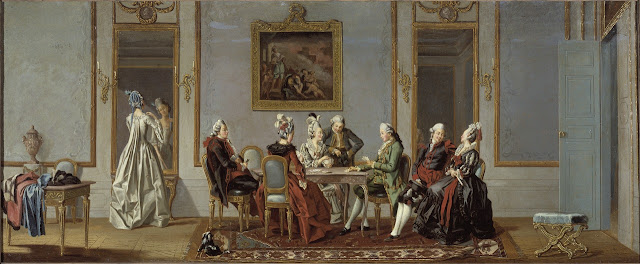 |
| Johan Robert Nilsson Gripsholm Castle Interior 1882 oil on panel Nationalmuseum, Stockholm |
 |
| Johan Robert Nilsson Gripsholm Castle Interior 1881 oil on panel Nationalmuseum, Stockholm |
 |
| Karl Nordström Gripsholm Castle Interior 1878 oil on canvas Nationalmuseum, Stockholm |
 |
| Oscar Björck Gripsholm Castle Interior 1878 oil on canvas Nationalmuseum, Stockholm |
 |
| Gustaf Cederström Theatre at Gripsholm Castle (from backstage) ca. 1870-80 oil on canvas Nationalmuseum, Stockholm |
"Gripsholm is known as Gustav Vasa's castle – he it was who built it as a defensive stronghold in 1537. One of eleven royal palaces in Sweden, Gripsholm Castle is surrounded by the waters of Lake Mälaren, and towers over the small town of Mariefred in Södermanland. The castle contains one of Europe's best-preserved theatres from the 18th century, which Gustav III designed and had built inside one of the round Renaissance towers, exclusively for the use and diversion of his court. Gripsholm also houses more than 4,000 paintings, comprising the Swedish national portrait collection."
 |
| Pehr Hilleström Gallery of the Muses in the Royal Museum at the Royal Palace, Stockholm 1796 oil on canvas Nationalmuseum, Stockholm |
 |
| Pehr Hilleström Inner Gallery in the Royal Museum at the Royal Palace, Stockholm 1796 oil on canvas Nationalmuseum, Stockholm |
 |
| Pehr Hilleström Gustavian-style Interior with Card Players 1779 oil on canvas Nationalmuseum, Stockholm |
"The Swedish Gustavian Style is named for King Gustav III (1746-1792), who introduced it for palace decoration in the 1770s and 80s. Gustav had visited the court at Versailles during the reign of Louis XVI, and was inspired by both the mid-century Rococo tradition and the emerging Neoclassical trends he observed in France."
 |
| Pehr Hilleström Card Party in the Home of Elis Schröderheim ca. 1780 oil on canvas Nationalmuseum, Stockholm |
 |
| Pehr Hilleström Interior of an Art Gallery ca. 1780 oil on canvas Nationalmuseum, Stockholm |
"In 18th century Europe there were three prototypes of the modern art museum: what may be called scientific collections of art (usually "cabinets" of, for example, medals, Etruscan vases, prints and drawings, gathered scientifically and with didactic purpose); palatial collections of the ruling class or of the amateurs attached to that class; and, actual museums of art with a custodial staff. These three types were subsumed in the 18th century into a greater type, the private collector, whether eccentric abate, powerful aristocrat, or reigning monarch. Obviously the typical representative was the powerful and princely collector, the resident of a palace. The palace, whether called palazzo, chateau, hôtel, house, villa, or country seat, whether occupied (as in much of Europe in the 18th century) by an aristocrat with feudal rights or by a wealthy bourgeois of position and note, was much the same from Sicily to Sweden, from Portugal to Scotland. It was a collection of people and a collection of complicated duties, privileges and wealth. All of these people and functions were appropriately ornamented and involved with art in a more simple and direct way than we are today, and more opulently. No person of position lived privately in our sense . . ."
– Anthony M. Clark, from The Development of the Collections and Museums of 18th Century Rome, published in Art Journal (Winter 1966-67)
 |
| Albert Edelfelt In the Drawing Room at Haiko 1888 oil on canvas Nationalmuseum, Stockholm |
 |
| Gustaf Cederström Carola sitting on the Sofa 1899 oil on canvas Nationalmuseum, Stockholm |
 |
| Albert Engström Portrait of the Artist's Father reading a Newspaper 1892 oil on canvas, mounted on panel Nationalmuseum, Stockholm |
 |
| Anders Zorn The Little Brewery 1890 oil on canvas Nationalmuseum, Stockholm |